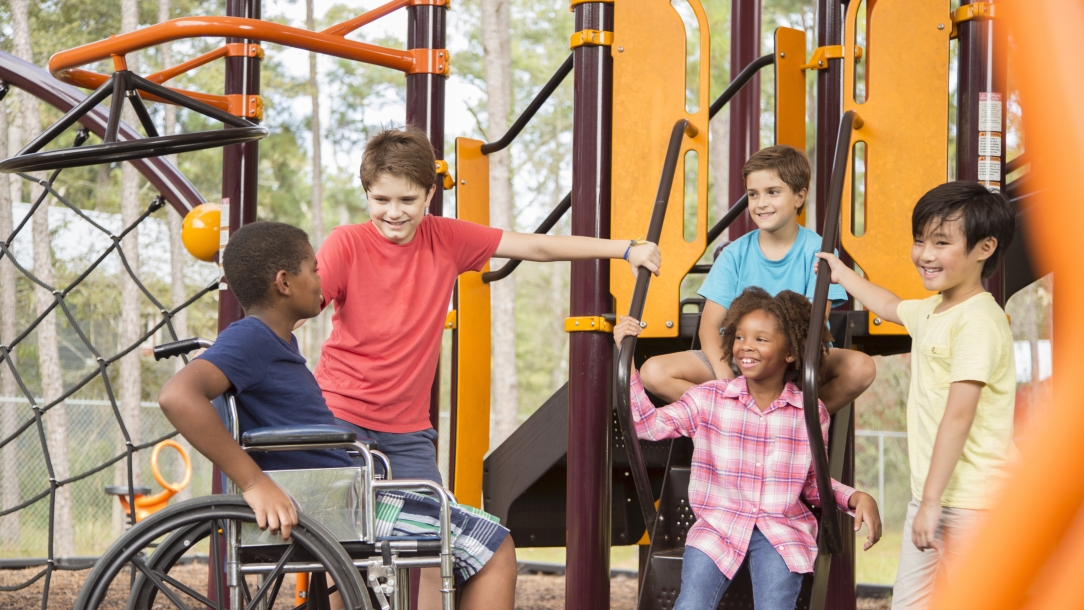Play is essential for people of all ages and abilities, but this is especially true for children. Playing on a playground gives them the outlet for their energy as well as plenty of time in the sunshine and fresh air. It helps them build social relationships as they interact with others. Parents who take their kids to the playground can attest to witnessing scenes of collaboration and conflict resolution, which are skills that will serve the kids well into their adult years. Playing on a playground encourages interaction among people from all walks of life, giving children the opportunity to develop relationships with others who do not have the same backgrounds or abilities as themselves.
Playgrounds fill a vital role in child development. Yet sometimes, playgrounds are not able to fulfill that role because of how they have been designed. Not all playgrounds are equal in providing accessibility to those faced with mobility challenges.
Accessibility Regulations and Realities
There is a foundational standard for accessibility in playground design. In 1991, the American Disabilities Act (ADA) was signed to federal law, and it was a first attempt to promote accessibility to places like playgrounds. This Act was further clarified by the American Society for Testing and Materials (ASTM) to provide better guidance on designing playgrounds and equipment for accessibility and safety. ADA and ASTM provisions have undergone several revisions since. Many believe, however, that these rules have not gone far enough to promote playground accessibility.
Mobility and cognitive challenges are more common than you’d think. Around 1 in 12 people in the U.S. under 65 years old has a disability. This means that around 8% of the population cannot easily use a standard playground that does not take differences in ability into account. Areas designed for play may be inadvertently excluding a significant portion of the population they’re intended to serve. This leaves communities without a place to gather, learn, and play together.
The solution is to design accessible and inclusive playgrounds that take a wide variety of challenges into account. By considering a variety of mobility and cognitive needs while still in the design phase, you can build a park that can fulfill its purpose of advancing safe play and healthy recreation.
Accessible Playground Paths
“Accessible” means a thing is able to be reached or entered. That is why we say every accessible playground design should start with looking at the paths or routes of travel to the play and rest areas. This includes all routes to accessible structures, equipment, and rest areas. Pathway surfacing should not only meet ADA requirements, but it should also be designed in a way that helps guide the way toward accessible play areas.
Access routes should be at least five feet wide and easily allow for two wheelchairs to pass each other. There should also be areas for people to turn wheelchairs around or to park a wheelchair while using the equipment (such as by the swings.)
If, like many playgrounds, your playground design includes using both loose and bonded surfaces, be aware of the challenges this will present someone using wheelchairs or mobility equipment such as leg braces and crutches. Ensure that surfacing leading to equipment made especially for inclusive play is accessible and easy to traverse. Also, be aware of tripping hazards where the bonded surface transitions to loose material. Consider designing pathways with gradually sloping edges covered with durable, bonded surfacing that doesn’t easily break down in order to prevent hazards such as wheelchair wheels dropping off the access path.
Accessible Safety Surfacing
While caregivers will play a role in the safety of some facing mobility challenges, others who are older or have more independence will handle chair-to-structure transfers or playground navigation on their own. Playground designers have a duty to provide a reasonable level of protection for everyone who uses their recreation area, but that duty is heightened for areas designed for accessible and inclusive play.
ASTM regulations provide guidance for when to use safety surfacing. However, playgrounds intended to meet the challenges of mobility disability will be considered safer and more “user-friendly” if it takes the extra step in choosing a surfacing with a base layer of shock-absorbing rubber material under a high density bonded rubber surface, such as our safety surfacing SpectraPour Supreme. The base layer provides the protection necessary for high-risk fall areas, especially around wheelchair-transfer areas or the bottom of slides. The high-quality top layer prevents the surface from breaking down and creating a trip hazard or uneven surface for wheelchairs.
Designing for Accessibility
The demand for accessible playgrounds is on the rise. While federal regulations are continuously refining in an attempt to create an equal opportunity for everyone to enjoy the benefits of shared recreation, they don’t keep up with our growing understanding of the varying challenges facing more than 8% of America’s population today. If you are designing a new park or upgrading a current park, you can save time and money by designing your playground for accessibility and inclusion from the very beginning.
At SpectraTurf, we are proud to support accessible park design. We offer a variety of ADA-compliant safety playground surfaces that will help you achieve your goals of designing a park that can be enjoyed by people of all walks of life. Contact us today to get started.

